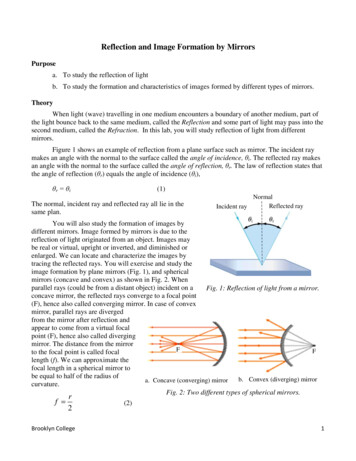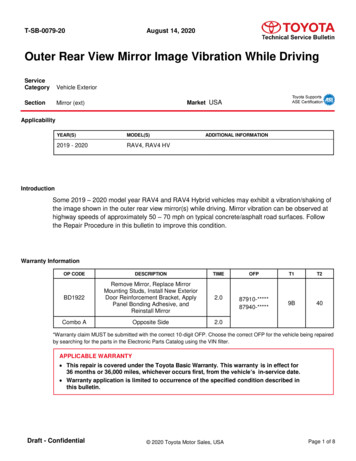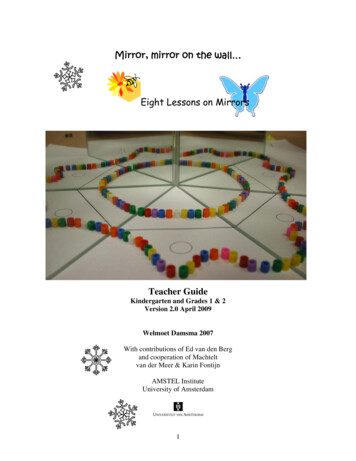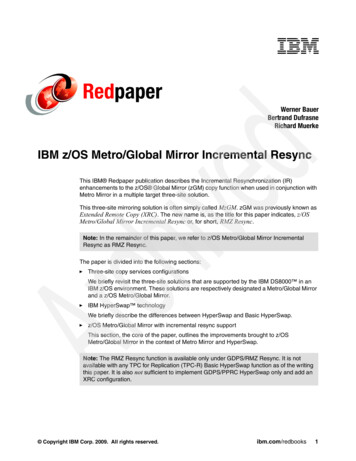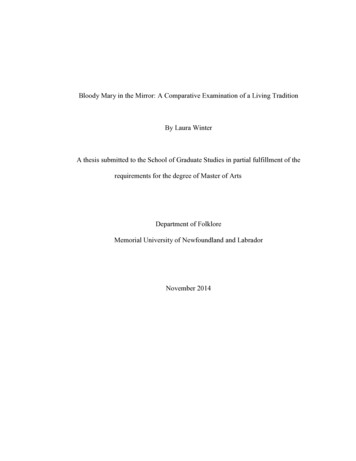
Transcription
Bloody Mary in the Mirror: A Comparative Examination of a Living TraditionBy Laura WinterA thesis submitted to the School of Graduate Studies in partial fulfillment of therequirements for the degree of Master of ArtsDepartment of FolkloreMemorial University of Newfoundland and LabradorNovember 2014
Table of ContentsAcknowledgements . . .3Abstract . .5Chapter OneIntroduction . .6Explanation of Informant Grouping .13My Own Experiences With Bloody Mary . .21Chapter TwoLiterature Review . . . .28Chapter ThreeComplex Generic Forms . .46Chapter FourRhetorics of Play in Bloody Mary . . 95Belief and Cultural Catholicism .101Chapter FiveInformants and the Function of Bloody Mary Among the Different Groups .114Table of Structural Elements .124Chapter SixContemporary School Children and Bloody Mary . .127Chapter SevenConclusions . 149Bibliography 1572
AcknowledgementsFirst and foremost I offer my sincerest gratitude to my supervisor, Dr. PhilipHiscock, who has supported me throughout my thesis with his infinite patience and vastknowledge. Thank you for guiding me along with gentle critique and great conversation.I would also like to thank Professor Shane O’Dea, whose unfailing belief in myacademic abilities since I first walked into his English 1103 class many years ago, isundoubtedly responsible for any and all of my academic achievements.Special thanks as well to Dr. Martin Lovelace for his keen eye and suggestionsabout the motif index.I am fortunate to have extremely understanding and generous parents, who have(seldom) questioned my long and winding journey, all in the name of curiosity. Theyhave happily supported my whims and, without that support, I never would have devotedseveral years of my life to researching a childhood fear and turning it into a Master’sthesis. The mere words “thank you” will never be enough.Of course, a debt of gratitude is owed to all of my informants: my formerschoolmates, who dug deeply into their memories to talk about Brownies and Catholiciconography; friends and friends of friends, who made the time to sit down and tell meabout slumber parties, graveyard trips and scary basement bathrooms; and the students ofvarious schools where I have taught during the writing of this thesis.I would particularly like to thank the children of Bishop Feild Elementary School,and all of the staff there, for their words of encouragement and interest in this project.3
Special thanks to Melissa Long, who somehow found time during her teaching internshipto tackle the arduous task of being my copy-editor. Thanks also to Anne Lafferty for herassistance with sources on handfasting rituals. As well, I would like to acknowledgeDanny Whalen for the time he took with my thesis and his encouraging words.Lastly, I would like to express my thanks to Erin Power, Jenina MacGillivray andKerrie Cochrane. Without our endless cups of tea, writing dates, sometimes titillatingconversations and your friendship, I never would have made it through this process. Youare brilliant people and inspire me in many ways.4
AbstractThis thesis is a cultural analysis of Bloody Mary, which exists simultaneouslyas legend, ostension, folk drama, maturation ritual, a demonstration of socialhierarchy within a folk group, and various types of play. I investigate Bloody Marythrough the lens of each of these genres, exploring retrospective narratives fromadults and teenagers, in addition to narratives collected from contemporary schoolchildren. Included in these groups are women who attended Catholic school in the1980s and consider themselves “cultural Catholics,” adults who grew up in St. John’s,Newfoundland during the 1980s but did not attend Catholic school, high schoolstudents from a small community just outside of St. John’s, and contemporary schoolaged children.Building upon the research of Langlois, Dundes, Tucker, Ellis, Armitage andwith consideration given to Sutton-Smith’s rhetorics of play, the presentinvestigation analyzes the function of Bloody Mary to each group of informants,extracting elements of similarities and variants that could be conceptualized through atable of structural elements in order to show mutations over time, geography andcultural groupings (such as religion and age). This comparative, cross-culturalexamination of contemporary usages and functions of Bloody Mary frames it asliving, dynamic folklore and an important aspect of children’s folklore/childlore.5
Chapter 1Bloody Mary is an adolescent ritual activity that has been commonly reportedfor nearly half a century from most parts of North America. This thesis isdocumentation, exploration and cultural analysis of that children's activity, along withits various uses and generic forms, as it has been known in and around St. John’s,Newfoundland, Canada, over the past twenty-five years. While Bloody Mary haslong been considered merely a game played by young girls, in this thesis, I considerBloody Mary as something that exists simultaneously as legend, ostension, folkdrama, maturation ritual, a demonstration of social hierarchy within a folk group, aswell as various types of play.In this thesis, I explore the various generic forms of Bloody Mary, as writtenabout by other scholars since the late 1970s. I then consider Bloody Mary as itpertains to my informants. As such, I examine the functions of Bloody Mary overtime (beginning with the early 1980s through to current school children), geography,and cultural sub-culture (Catholic children compared to non-Catholic children). Inexploring the Catholic sub-culture, I encountered an aspect of Bloody Mary that wasexclusive to this group, and will thus examine the concept of a “Catholic ecotype” asapplied to Bloody Mary. I also discuss the changes in transmission of Bloody Maryand the dynamic nature of Bloody Mary as it relates to children’s folklore.Throughout this thesis, I reference four main groups of informants using asystem of acronyms and within these groups, the informants are referred to using their6
first name (in most cases) and the first initial of their surname. In cases where I useonly initials, it is at the request of the informant. I will briefly outline the referencingsystem here, with more detailed explanations given later in this chapter. The firstgroup of informants will be referred to as “Former Catholic School Attendees”(FCSA), and consists mainly of my peers, those who attended St. Pius X School at thesame time I did (in the 1980s). There are several other women in this group who didnot attend the same school but attended other Catholic schools in the St. John’s areain the same period, and these are noted as slight variations. Another group ofinformants are high school students from Crescent Collegiate School inWhitbourne/Dildo, NL, where I worked briefly as a substitute teacher in 2009. Thisgroup of informants are referred to as “Whitbourne/Dildo” (WD). The next group ofinformants are contemporary school children, who were attending elementary schoolwhen I interviewed them. They were in a variety of grades and attended severaldifferent schools, and will be referred to as “Contemporary Elementary Students”(CES). The final group of informants were not chosen as informants intentionally,but rather serendipitously, and are referred to as “Folklore Interviews” (FI)throughout this thesis. They were often friends, or even friends-of-friends who,through casual conversation, took an interest in my topic and volunteered to be part ofmy research.MethodologyMuch of my early research for this thesis began as a term paper (as describedbelow), and as I spoke with the students who became the second group of informants7
(WD students), the idea of a cross-generational comparison began to emerge. I wasfortunate that my profession as a classroom teacher afforded me the opportunities tospeak with children of various ages about their Bloody Mary experiences. Afterdoing fieldwork with my peers and high school students, I found that I encounteredother informants almost “accidentally” through conversations at parties or in othersocial settings, such as school staff rooms. When I returned to teaching in a lowergrade level classroom at Bishop Feild Elementary, the Bloody Mary activity onceagain came up among my students without me seeking it out. And so, as I began toanalyze the narratives and experiences of these four groups of informants (FCSA,WD, FI and CES), many similarities emerged, for example, in the invocation ofBloody Mary and the prescribed setting used by most informants, yet the differencesin usage, or functionality lead me to consider the multi-generic nature of BloodyMary. I then sought out previous scholarship on the topic, or on closely related topicsand considered where my own fieldwork fit with the work of other folklorists.How I Came Into This TopicI stumbled upon the topic when researching a term paper for a graduate course,Language and Play (FL6250), in 2009. I had chosen to write my paper on slumberparty games played by my group of friends when they were pre-adolescents andteenagers. I began to ask my friends – consisting of women born in the mid-to-late1970s – about their recollections of games and activities that were commonly playedat sleepovers and slumber parties of our youth. Their recollections included games8
such as “Truth or Dare,” sometimes referred to as “Truth, Dare, Double Dare,Promise to Repeat.” This activity involves the several choices given in the name ofthe game. Each participant is asked which they would prefer: to answer a questiontruthfully (which was usually quite personal and involved something that theparticipant may have been keeping a secret); to take on a dare, which in those days(before the technology of caller ID) often meant a prank phone call; to take on adouble dare, which was a far more extreme dare, that may have involved leaving thehouse and running to ring a neighbour’s doorbell late at night, or sneaking into theroom of a sibling of whoever was hosting the sleepover and stealing their underwear.The “promise to repeat” aspect was usually frowned upon and considered “wussy”because no personal risk was involved. If someone chose “promise to repeat,” theringleader of the group would usually give them something embarrassing to repeat,such as declaring their love for someone extremely undesirable in their class. (SusanL-FCSA/12)An activity recollected by informants was using the Ouija Board, which, inher article “Spooky Activities and Group Loyalty” Shaari Freed explains as follows:When participating in a Ouija board session, players sit around a game board(either homemade or store bought) which has the letters of the alphabet as wellas the words “yes,” “no,” and “good-bye” written on it. The players each placeone finger on an upside down glass, or some other marker, which the spiritwill use to indicate the desired letter. The players usually say a shortinvocation inviting spirits to join them. They then proceed to ask variousquestions of the spirit (e.g., “Who will I marry?” “Which boy likes me?”).(Freed 1994: 33-39)9
Similar to this context, Jeanne Myrick examined Ouija Board usage in Newfoundlandand noted the social setting under which her informants used the Ouija Board, whichwas always “among friends” (Myrick 1999: 162).My friends also recalled playing “Light as a Feather, Stiff as a Board.” In her2008 article “Levitation Revisited,” Elizabeth Tucker deals with this activity atlength, determining that it is primarily a preadolescent activity dating back as far asthree centuries. She writes,One intriguing but understudied form of children’s folklore is levitation, aritual in which several pre-adolescents or adolescents lift a friend with only afew fingers of each hand. Sometimes the individual who gets lifted lies on thefloor; other times he or she stands or sits in a chair. Records and studies sincethe seventeenth century have identified this process as a “spell,” an“inchantment,” a “curiosity,” a “game,” a “trick,” a “procedure,” or an“activity.” (2008: 47)Tucker notes her own use of Mary Douglas’s definition of ritual as symbolic action,The presence of certain symbolic elements [in levitation], over a wide span oftime and space, creates a sense of ritualistic potency. As in many rituals, theorder of events must be faithfully maintained, the tone must be solemn, andthe outcome is expected to be something almost miraculous; so the word“game” does not quite do justice to the nature of what is happening. (Tucker2008: 47, Douglas 1973:126)In adapting Tucker’s usage of Douglas’ definition, and applying it to my ownwork on Bloody Mary, I came to realize that the term “game” was not whollyaccurate. In considering this problematic word “game,” it is important to note that10
Bloody Mary is not merely any competitive game of childhood, such as baseball orhopscotch. Although I will use the term “game” to refer to Bloody Mary, and assuch, the verb “play” is employed to accompany the term “game,” Bloody Maryserves many functions to its participants. These functions vary, often based on theage of participants, and how and when they partook in Bloody Mary. As I willdiscuss in Chapter Four, belief is an integral aspect of “playing” Bloody Mary, andthe children involved often believe that Bloody Mary would appear to them, whichmakes the “game” quite serious for some of them.Tucker’s earlier article on levitation (1984) discusses the varying “chants,stories and processions” (127) that she encountered through her research andinterviews with pre-adolescent girls. There are parallels between these narratives andthose I encountered in my Bloody Mary research, and much of Tucker’s analysis ofthe story-telling that accompanies the levitation activity is congruent with my idea ofBloody Mary being considered a form of ostension or even legend tripping.Although the Bloody Mary activity of my childhood did not use much in the wayof narrative leading up to actually engaging in the activity, almost all of my otherinformants (“other” being non-Catholic school attendees), told me about theconversations that led up to their participation in Bloody Mary, whether it was a storyabout the origin of Bloody Mary, who she had been while still alive, or a story aboutwhat had happened to someone they knew who had summoned Bloody Mary.In continuing my research on slumber party games, several other friends talkedabout using Tarot cards or even a pack of common playing cards to tell one’s11
“fortune.” The informants involved referred to “fortune telling” but, in actuality, thecards were specifically and exclusively used to divine who the participant’s nextboyfriend was going to be (Susan L-FCSA/2009), which at that age (twelve tofourteen) was one of the most important things on one’s mind.Eventually, among the various slumber party activities we discussed, one ofmy informants mentioned playing Bloody Mary. This struck a chord with me forseveral reasons. The first reason is that Bloody Mary was an utterly terrifying part ofmy childhood – for years, I scuttled past mirrors in darkened rooms, for fear of“accidentally” even thinking about Bloody Mary if I glanced at my reflection.However, it was the second aspect of hearing this particular informant recollectplaying Bloody Mary that led me to further consider the topic. This particularinformant described the “end result” of the game – that is, who or what wouldsupposedly appear in the mirror. Her deviation from my own experience was sosurprising to me that I decided to explore the topic further. Casual questioning ofother friends and acquaintances in St. John’s on the some topic indicated that therewere not only far more variations than I had originally anticipated, but also that oneparticular group of people, Catholic school attendees in the 1980s – my own peergroup – seemed to have a particular ecotype that no other individuals had. With thisrealization in hand, I began to dig deeper.12
Explanation of Informant GroupingThis thesis looks at several different groups of informants, and so my researchand analysis generally consider, and refer to, groups of informants. There areindividuals quoted throughout, but they are almost always identified as being part of agroup of informants. These groups are divided by religion, gender, geography andgeneration.My first group of informants was my friend group, women who had attendedCatholic schools in St. John's, Newfoundland, in the 1980s. St. John's is a mediumsized city, with a population of 150,000 – 200,000, depending on where one draws theline between city and suburb. According to Statistics Canada (statcan.gc.ca), thepopulation of the municipal area in 2011 was 196,200. St. John's is a port city,having developed as a result of the commerce built around St. John's harbour,including fishing and shipping. The residents of the city are primarily of English,Irish and Scottish descent. As a result of this ancestry, English Protestantism, IrishCatholicism and Scottish Presbyterianism are prevalent as the “mainstream,”commonly held, belief systems. There is a long-held understanding of a culturalrivalry of sorts between the Catholics and the Protestants, and one of the mostobvious by-products of this religious segregation was, for many years, adenominational school system. Beginning in the nineteenth century, and up until1998, schools in St. John's were governed by two different school boards, the RomanCatholic School Board and the Avalon Consolidated School Board.Which school one attended depended on both address and religious beliefs or, at least,13
those of your family.It may be important here to explain that while attending Catholic school in St.John's did not guarantee a development of the Catholic faith, it was at the very least, acultural determination for many aspects of one's young life. Even now, as an agnosticadult, I frequently happen upon colloquial expressions and “superstitious” practicesthat I had not previously identified as being “Catholic.” While “superstitions” and“superstitious” are not generally used by folklorists, in this thesis these words mayappear within quotation marks, as they are used by informants. As such, I haveapplied a working concept of “cultural Catholicism” (the folk beliefs involvingexpressions, exclamations, swear-words and customary actions that have developedout of Catholic doctrine, but are no longer or not necessarily a part of “official” beliefsystems – further discussed in Chapter Four) as it pertains to many of my informantsand has helped to formulate my idea of a Catholic ecotype as applied to Bloody Mary.My first exploration approached Bloody Mary as a children's activity, or game.For some of my informants, it was firmly associated with slumber parties, Ouijaboards and Truth or Dare. However, these categorizations bring about questions thatlead to other determinations in the folkloric spectrum. The specifics of where it isplayed, how it is played, who plays it and the variations in script and action open upmany possibilities to consider. In my experience, it was a form of play-acting byyoung girls. My friends and I would summon some sort of “mirror witch” (Tucker2007: 95), while pretending not to be scared in front of each other. We considered it agame, but from a folklorist’s perspective, it is also a form of folk drama. There is a14
prescribed setting and in some cases an accompanying narrative, which can lead tocategorizing it as a form of belief narrative. The anticipated spectral vision in themirror is thought by some to be malevolent and capable of harming those involvedphysically, so Bloody Mary can certainly be considered a form of supernaturalfolklore. However, localization of the origins of Bloody Mary and an accompanyingnarrative of the belief amongst some of my informants puts Bloody Mary in the realmof legend and ostension. I have also considered Bloody Mary from the perspective ofa maturation ritual, and in this thesis, draw on the work of Alan Dundes and hispsychoanalytical approach to folklore to further develop this idea. An additionalthought, something I must consider from my current perspective as a classroomteacher, is Bloody Mary as a form of bullying which, for some girls, is something of acoming-of-age event. As well, I consider Bloody Mary in a contemporary context –not only through fieldwork conducted with contemporary school children and theirknowledge and participation in Bloody Mary, but also considering the transmission,usage and adaptation of Bloody Mary through the use of the Internet and other formsof media. As there are now many other forms of popular media available to children(compared to the limited availability of my own youth, which would have meantmainly books, movies and television), consideration will be given to other forms ofmedia that would act as forms of transmission, such as YouTube, e-mail chain lettersand websites.The current version of Bloody Mary has been heavily influenced by popularculture. I explore how this affected several elements of the Bloody Mary activity – the15
visual (what was seen in the mirror or expected to be seen), the contextual (what wassaid and how it varied among informants), and the possible sources for similarities(popular movies, for example).In doing fieldwork for my paper on girl's slumber party games, Ideveloped my interest in Bloody Mary, based in part on my own childhoodexperiences and the fear of looking at a mirror in the dark, which has never quite leftme. My original fieldwork was limited to my peer group and, as I interviewed friendsand colleagues about an aspect of their childhood that most had not thought about inover twenty years, I discovered something that I had never considered before: aschildren in Catholic school, we anticipated seeing the Virgin Mary in the mirror, andthat was not the commonly reported form in the previously published scholarlyliterature on Bloody Mary. When I asked other non-Catholic friends about theirexperiences with Bloody Mary, there was quite a variation in the anticipated result ofthe ritual, but not a single one of them mentioned expecting to see the Virgin Mary inthe mirror. When pressed to recall details of this aspect of their elementary schoolyears and tell me whom they expected to see in the mirror, Catholic school attendeesresponded that the Virgin Mary (Jesus’ mother) was the anticipated figure in themirror. The varying responses from non-Catholic respondents will be consideredfrom several different perspectives. Firstly, it was among this group of informantsthat I found the most narratives explaining who Bloody Mary was, or why she was inthe mirror. These narratives are examined and considered from several differentfolkloristic lenses, including legend-tripping and ostension, as discussed by Linda16
Dégh (2003) and Bill Ellis (1982/83). Secondly, it was among these non-Catholicinformants of varying ages and several generations that I found the most variation inritual and the anticipated vision in the mirror. Despite this variation, onecommonality that is worth further consideration is the recurring idea of a violent ormalevolent female figure. As summoning Bloody Mary frequently was (and still is,as discussed throughout this thesis) undertaken in the elementary school bathroom, asetting in which most authority figures are female, I will also explore gender in thecontext of play.My first group of informants is composed entirely of women, as my originalfocus was on girls’ slumber party games. However, as my interest in this topicdeepened, I decided to branch out further, and conduct some interviews with currentschool-aged children. Among this group, there are both boys and girls, as I havefound that Bloody Mary is – in 2014 – no longer restricted to female audiences orparticipation. This group of informants will be referred to throughout the paper usingtheir initials, the acronym for Contemporary Elementary Students (CES) and the yearin which the interview was conducted (for example, HC-CES/11).When interviewing children, there are several ideas that must be considered.First of all, the collector is viewed as something of an outsider – an adult in a child'sworld. This has worked both for me and against me in conducting interviews withchildren. In some cases, the children I interviewed were the children of friends andcolleagues. In these cases, I was able to approach the interviews in a less formalsetting. In each case, I encouraged the parents to leave the room, and in a slightly17
conspiratorial tone, pointed out that the child should call me by my first name, not“Ms. Winter,” as some of their parents might have suggested. I also found thatoffering “Gummy Worms” (a popular candy amongst children of that age group),finding common interests in books and other aspects of popular children's culture alsomade for common ground, and allowed me to be “let in” to their world a little bitmore than they may let their parents. I often started off the interviews sharing someof my own Bloody Mary stories and admitting to having a lingering fear of the dark.In these particular interviews, I felt as though I had been fairly successful in breakingdown the barrier between adult and child. Sylvia Ann Grider has written about thecollecting children's folklore, and makes some essential observations that I consideredwhen embarking upon this project.A certain self-recognition is inherent in the study of childlore . However,because we as adults are so close to the material which we once shared, wetend to gloss over much of it because we regard it as obvious.(1980:161)Being “close to the material” was sometimes a challenge when collecting fromchildren for this thesis. All adults were children themselves, but it is important not toconsider ourselves “experts” when it comes to aspects of childhood that we areapproaching as collectors and folklorists. For me, maintaining neutrality duringinterviews was sometimes difficult, especially since Bloody Mary was quite relevantto my own childhood experiences. When discussing it with children, I did not want tocolour their narratives in any way, or use suggestive or leading language or questions.Gary Alan Fine has noted that children are their own distinct folk group (Fine18
1980:172) with their own stages of cognitive, physiological and social development.With this in mind, I interviewed children ranging in ages from six to sixteen, usingdifferent techniques and with varying objectives.During the spring semester of 2009, while completing my graduate coursework, I was doing a brief replacement for a teacher at a school in Whitbourne/Dildo, acommunity just about an hour’s drive outside of St. John's. There, I spent threeweeks as the French teacher at Crescent Collegiate High School and one day, whilechatting with a group of students while waiting for the rest of the class to filter intothe room, the students asked about my master's program and I told them about thepaper I was currently working on. I had not realized at this point that Bloody Marywas still practiced by contemporary children and engaged the students in aconversation about Bloody Mary. This particular group of fifteen-and sixteen-yearolds were eager to help, sharing their stories and experiences with me. While I tookas many notes as I could during our conversations, I did have the responsibility ofbeing primarily their French teacher, so eventually had to turn the conversation toFrench verbs. However, I asked them to write down anything they wanted to sharewith me for my paper and took away several handwritten accounts of theirexperiences of Bloody Mary.These narratives and the accompanying notes and conversations that I use inthis thesis will be referred to as Whitbourne/Dildo 2009, using the initials of theinformant beforehand to distinguish the source (for example, NH-WD/09). Thisgroup consisted of high school students, and also showed the most variation in their19
narratives and personal experiences. These students live in a relatively smallcommunity and have gone to school together their entire lives, yet had the mostvariation in narratives about Bloody Mary. When asked about their experiences withBloody Mary, most of the responses I was given were accompanied by local lore andlegend. Their localization of Bloody Mary was, to me, another indication that BloodyMary could be further explored in other genres, not “just” as a children's game.Another point of interest among these informants was that all of the girls whoresponded to my questions claimed to have participated in Bloody Mary at a muchlater age than my original group (my peers) of Former Catholic School attendees. Mypersonal experience with Bloody Mary was at quite a young age, lasting until aboutGrade Five (age ten), whereas the group of Crescent Collegiate students “played”Bloody Mary in school when they were in middle school, Grades Five, Six andSeven. These girls admitted to using Bloody Mary as a scare tactic on younger girls ifthey were unfortunate enough to be in the girls’ washroom at the same time. The girlsstated that they were engaging in this particular activity (scaring younger girls)because the same scare tactic had been used on them by the older girls when theywere in lower grades. Scaring younger pupils with tales of haunted bathrooms andlocal witches seems to be a part of the school culture in this group. I also saw thesame use of Bloody Mary amongst my youngest informants, who are currently ofelementary school age. Bloody Mary has come up in chain emails (further discussedin Chapt
Bloody Mary in the Mirror: A Comparative Examination of a Living Tradition By Laura Winter A thesis submitted to the School of Graduate Studies in partial fulfillment of the requirements for the degree of Master of Arts Department of Folklore Memorial University of Newfoundland and Labrador November 2014



